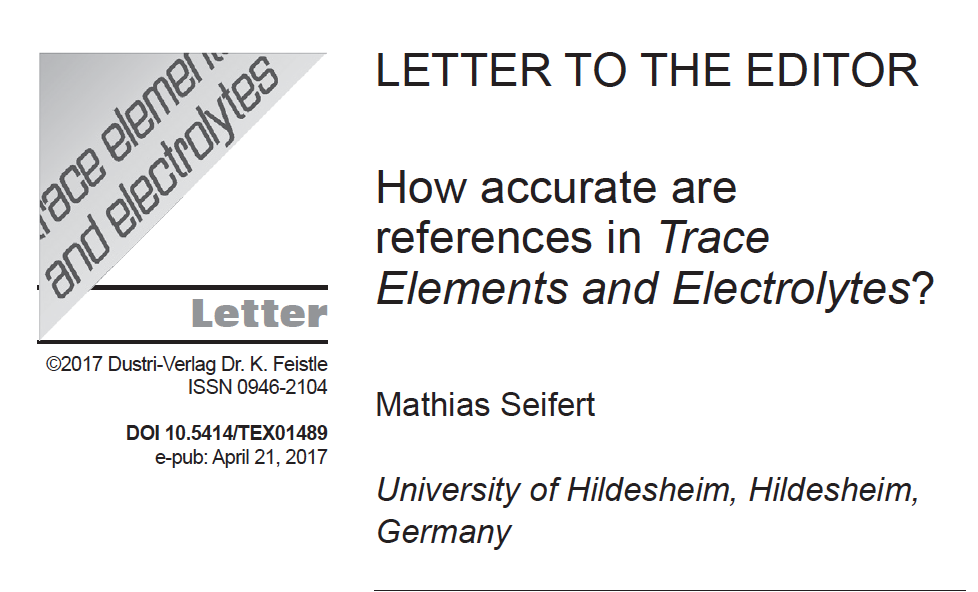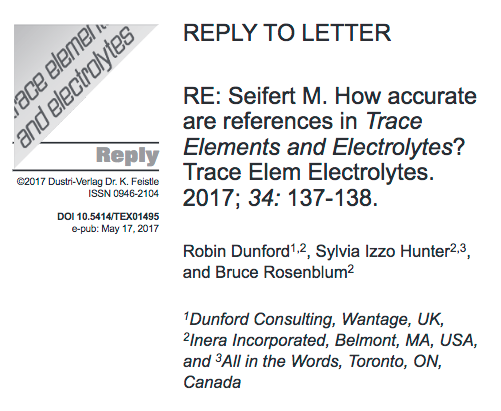 Whether you’re a publishing professional, a journal editor, a researcher, or a software developer, it’s great to see your work achieve its goals out in the world. So we at Inera were delighted when our customer Dustri-Verlag shared with us a letter to the editor of one of their journals, Trace Elements & Electrolytes, by Dr. Mathias Seifert of the University of Hildesheim, Germany. Dr. Seifert’s letter documents a thorough analysis of citation accuracy in TEE.
Whether you’re a publishing professional, a journal editor, a researcher, or a software developer, it’s great to see your work achieve its goals out in the world. So we at Inera were delighted when our customer Dustri-Verlag shared with us a letter to the editor of one of their journals, Trace Elements & Electrolytes, by Dr. Mathias Seifert of the University of Hildesheim, Germany. Dr. Seifert’s letter documents a thorough analysis of citation accuracy in TEE.
Previous studies of citation accuracy in scientific and medical journals (see here for references) have found error rates ranging from 8% to 66%. While some may seem minor—a one-digit discrepancy in starting page number, a single word missing from an article title—errors and inaccuracies in reference lists are cause for concern because even small errors can make the source material more difficult for readers to find. As more and more published reference lists become part of the Internet record and come up in online search results, inaccurate citations can propagate more quickly across publications, multiplying confusion and making the discoverability problem worse. The error rate Dr. Seifert found in volume 31 of TEE, however, was less than 5%—that is, just 31 of 643 references analyzed contained an error, which is significantly below the industry average. Why?
 Of course, reference accuracy in journals is a shared endeavor that relies on the careful work of authors, editorial office staff, copy editors, and proofreaders. As we all know, however, people in all of these roles have increasingly more on their plates, and manual reference checking takes a great deal of time that most of them simply don’t have—or reduces the time available for other key editorial tasks. Fortunately, while only humans can conduct research, restructure a confusingly worded sentence, or fact-check a manuscript, sophisticated software tools exist that can help journal staff in their quest to improve reference accuracy!
Of course, reference accuracy in journals is a shared endeavor that relies on the careful work of authors, editorial office staff, copy editors, and proofreaders. As we all know, however, people in all of these roles have increasingly more on their plates, and manual reference checking takes a great deal of time that most of them simply don’t have—or reduces the time available for other key editorial tasks. Fortunately, while only humans can conduct research, restructure a confusingly worded sentence, or fact-check a manuscript, sophisticated software tools exist that can help journal staff in their quest to improve reference accuracy!
Many publishers have adopted software tools that automate repetitive copyediting tasks in order to save time and money. What is less often appreciated is that editorial software can also improve reference accuracy. Like other Dustri-Verlag journals, TEE is processed through Inera’s eXtyles software, which automates reference correction and linking to Crossref and PubMed databases, so that as many references as possible can include clickable persistent links—with no manual searching by authors, editorial staff, or freelancers.
eXtyles PubMed and Crossref checking improve reference accuracy in two ways. First, eXtyles fills in missing information (e.g., page numbers) and corrects minor transcription errors (e.g., a missing word in an article title) based on curated PubMed metadata. Second, by identifying and flagging discrepancies between reference entries and the Crossref or PubMed metadata for the cited source, eXtyles prompts editorial office staff, freelancers, or authors to investigate, which allows them to find and correct errors in an efficient, targeted way. By using eXtyles, Dustri-Verlag journals have been able to eliminate most citation errors, bringing their citation error rates well below the industry average.
Dustri-Verlag kindly invited Inera to respond to Dr. Seifert’s letter. Before doing so, we conducted some data analyses and tests of our own, which found some interesting patterns in the types of errors Dr. Seifert uncovered. The most important finding was that the errors found in TEE were mostly of the kind that software can’t resolve: errors originating with authors or publishers, or errors in sources not available online. Taken together, Dr. Seifert’s findings and our own demonstrate that Inera’s software does its job well, while also offering concrete suggestions for further improving reference accuracy beyond the use of software.
You can read both Dr. Seifert’s letter and Inera’s reply in PDF format. And if you’re looking to improve reference accuracy in your own publications, please contact us to learn how our software solutions can help.
Citation accuracy is key to scholarly communication, and we’re always looking for ways to improve it. Thanks again to Dustri-Verlag and TEE for inviting us to participate in this discussion!